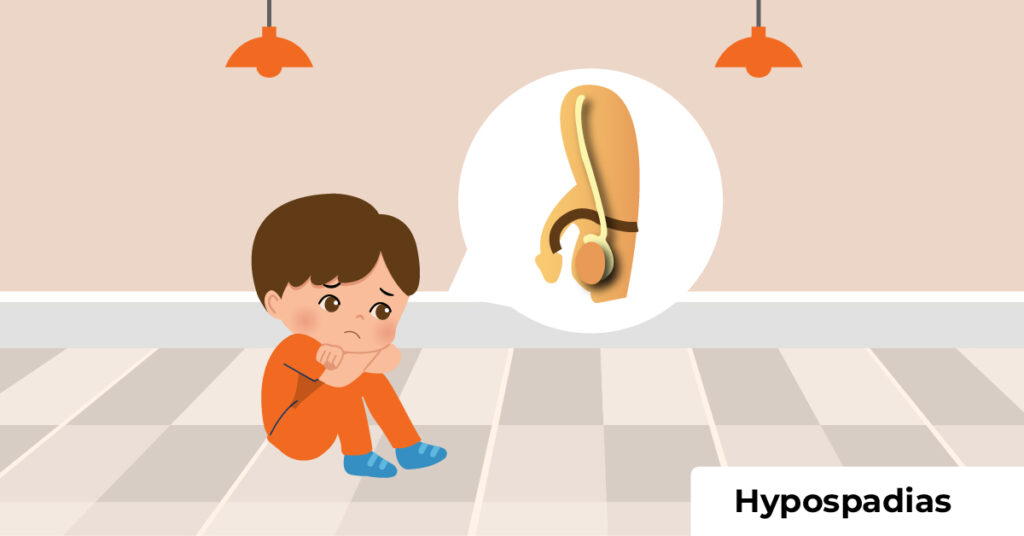
Ques. 1 What is Hypospadias?
Ans. Hypospadias is a birth defect where the urethra doesn’t develop properly in a baby’s penis. The urethra is the tube that carries urine and sperm through the penis to exit the body.
Ques. 2 How does Hypospadias affect the Penis?
Ans. Early in a baby’s development, the urethra starts as an open channel. The tube closes as a baby develops before birth. The urethra’s opening — where sperm and urine exit — is called the meatus (me-ATE-us). Typically, the meatus is at the tip of the penis.
Ques. 3 What are the types of Hypospadias?
Ans. Healthcare providers describe the type by where the urethra opens:
Subcoronal: Near the head of the penis.
Midshaft: Along the penis shaft.
Penoscrotal: Where the penis and scrotum meet.
Ques. 4 Is Hypospadias the Same as a Curved Penis ?
Ans. They are not the same condition. But babies with hypospadias can sometimes have a curved penis, called chordee or congenital penile curvature.
Ques. 5 How common is Hypospadias?
Ans. Hypospadias is common. It affects approximately one of every 250 to 300 new-born males. The rate seems to be rising in Western cultures — possibly because of the increased use of pollutants and pesticides.
Ques. 6 What causes Hypospadias?
Ans. Researchers don’t know exactly what causes hypospadias. However, it does seem to run in the family. Children with hypospadias are slightly more likely to have fathers and brothers who also have it.
The problem occurs during pregnancy. The penis begins to develop at around the eighth week of pregnancy. The urethra defect happens between weeks nine and 12.
Certain factors in the mother can increase the risk of the baby having hypospadias, including moms who:
- Carry extra weight (obesity).
- Are over age 35.
- Use fertility treatment to get pregnant (possibly because of exposure to progesterone, a hormone used during fertilization).
- Use other hormones before or during pregnancy.
- Have exposure to pesticides.
- Smoke.
Ques. 7 What are the Symptoms of Hypospadias?
Ans. In children with hypospadias, symptoms include:
- Chordee: Penis curves downward.
- Undescended testicle: One of the testicles doesn’t fully descend into the scrotum (in about 10% of cases)
- Undeveloped foreskin: The skin that covers the head of the penis isn’t complete. Babies with hypospadias should not be circumcised.
- Abnormal urination: Urine doesn’t spray in a straight stream.
Ques. 8 How is Hypospadias Diagnosed?
Ans. Healthcare providers usually diagnose this condition when a baby is born. Checking for hypospadias is part of the routine newborn examination after birth.
It’s easy to notice the problem: The hole of the penis is in the wrong place. Often, the foreskin is unformed, so the tip of the penis is exposed.
If the pediatrician detects hypospadias, they’ll refer you to a pediatric urologist for treatment. Hypospadias repair can correct the problem.
Ques. 9 How is Hypospadias Treated?
Ans. Surgery can correct hypospadias. With newer surgical methods, children can have corrective surgery at an earlier age. Your healthcare provider will discuss the exact timing of your child’s surgery.
Many pediatric urologists do the surgery when your child is between six and 12 months old . At that age, it’s easier to care for the surgery site after the operation. It’s also safer for your child to have anesthesia.
Ques. 10 What is the Goal of Hypospadias Surgery?
Ans. The goal of hypospadias repair is a straight penis with a urethra in the right spot, at the penis tip. Babies with hypospadias should not be circumcised. The surgeon may use extra skin from the uncircumcised foreskin to do the repair.
During the surgery, the urologist:
- Straightens the penis shaft.
- Builds a new urethra.
- Positions the urethral opening at the tip of the penis.
- Reconstructs the foreskin.
